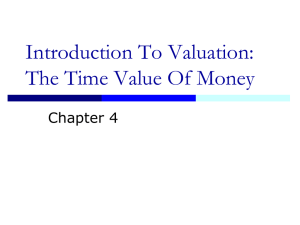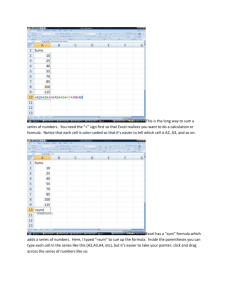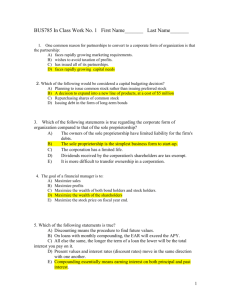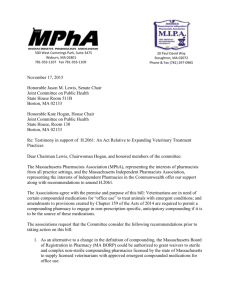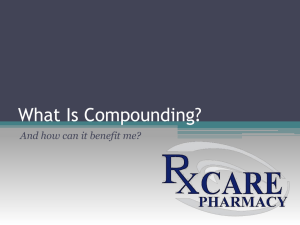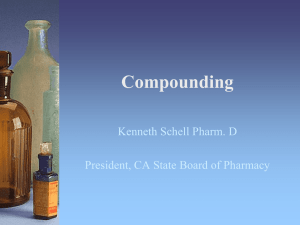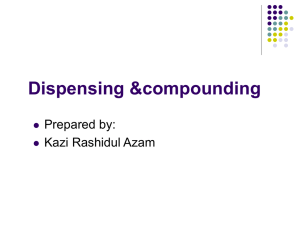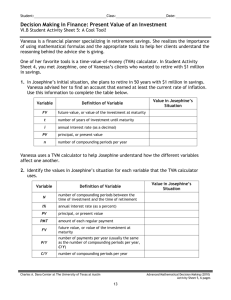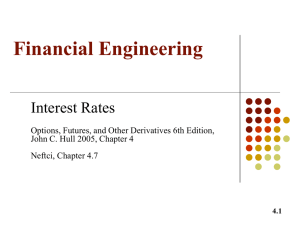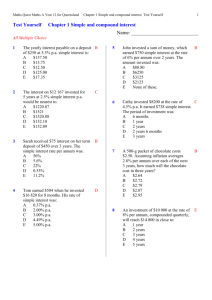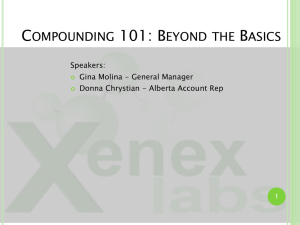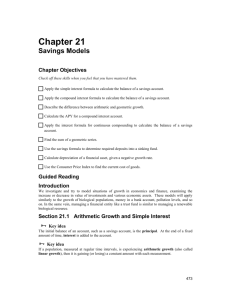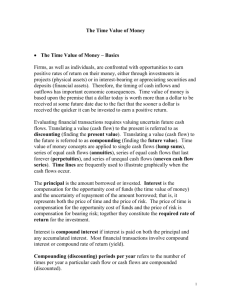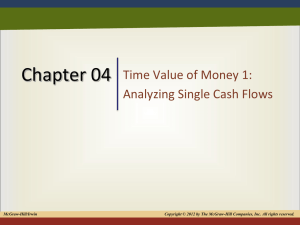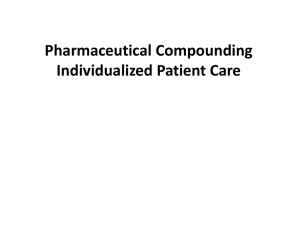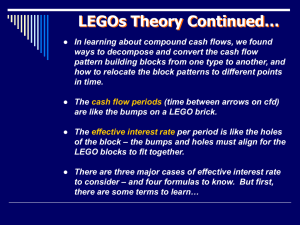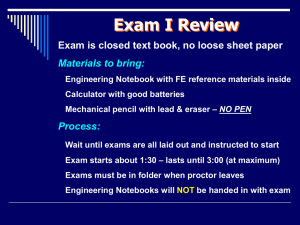File
advertisement
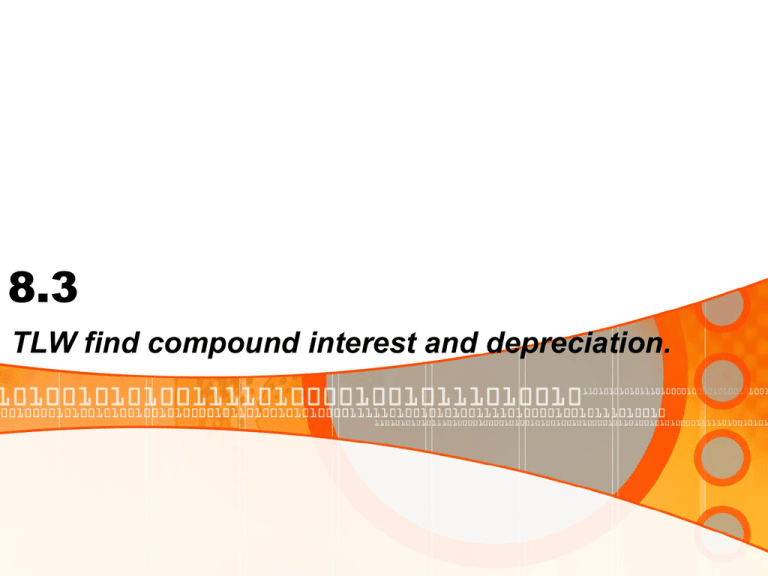
8.3 TLW find compound interest and depreciation. Compound Interest • You earn interest on capital AND previously earned interest. • Interest on interest Simple Interest • A gradual increase • Initial value used to find interest • Unfair to the investor since there is actually more value than the capital • Total Value = 𝐶 1 𝑟 𝑛 + 𝑛 • Total Interest = 𝐶 1 + 𝑟 𝑛 𝑛 −𝐶 Why? Example • Lars invests 10 000 Swedish krona (SEK) at a rate of 5.1% compounding yearly. Calculate the amount in Lars’s account after 4 years and find how much of that amount is interest, Give answers correct to 2 d.p. Another Example • Giovanni’s bank manager told him that if he invests 3000 EUR now, compounding yearly, it will be worth 4600 EUR in 5 years’ time. Another, another example • Marina is saving to buy a small boat that costs 35 000 USD. She has 28 000 USD in an account that pays 5.34% interest compounding yearly. How must Marina wait before she can buy the boat? • Setup: • Let’s use Solver to find the answer. Compound Interest and the GDC • In APPS you will find Finance • Use TVM Solver • N = # of time periods ( # of years) • I = interest rate • Can be negative if we are computing depreciation • PV = principal (C) • This is relative to the investor. Money invested is outgoing and therefore entered with a negative sign. • If the money is borrowed, then it is positive. • PMT = extra payments (none) • Negative if money is borrowed • FV = final value • This is positive because it is paid to the investor at the end of investment • • • • P/Y = payments per year, leave as 1 C/Y = compounding events per year PMT END BEGIN = when to apply interest in the period Place the cursor on what you’re solving for and press ALPHA ENTER to solve. Again but with GDC • Marina is saving to buy a small boat that costs 35 000 USD. She has 28 000 USD in an account that pays 5.34% interest compounding yearly. How must Marina wait before she can buy the boat? Subdivided Time Periods • Formula: 𝑇 = 𝐶 1 𝑘𝑛 𝑟 + 100𝑘 • k = how many times compounded in one year • 𝐼 =𝐶 1+ 𝑘𝑛 𝑟 100𝑘 − 𝐶 finds just the interest • Possible “k” in a year • • • • • Quarterly – 4 times Weekly – 52 Daily – 365 Monthly – 12 Half yearly – 2 • Actual Interest: Divide interest rate (nominal rate) by the number of times compounded in a year. • The bank in Grabiton is advertising a nominal yearly rate of 5% with compounding applied quarterly. State the number of compounding periods for a 3-year investment and find the actual interest rate applied after each time period. • Fleur invests 500 GBP in this bank for three years. Calculate the total capital in her account after this time. • Suppose Fleur invests this money at a rate of 5% p.a. compounding only once a year. How much less interest would she receive? A Real-life Example • A bank in Australia is offering a “term-deposit” account with a choice of interest rates. As long as you leave your money with them for 2 years, you can get a nominal rate of • 5.05% compounded monthly OR • 5.10% compounded quarterly OR 5.15% compounded half-yearly OR • An actual yearly rate of 5.2% Abigail has 7000 AUD to invest. Which is her best option? Remember you must show your method on Papers 1 and 2 or lose all the marks. • Annoushka has 2736.74 EUR in her bank account. She has left her money there for exactly 3 years at a nominal rate of 4.1% p.a. compounding daily. Calculate, correct to the nearest EUR, how much Annoushka put in the account when she opened it. (Assume there were no leap years in that time.) • Check with GDC. How does this connect to geometric sequence? • Simple interest– we add equal amounts • Compounded interest– we multiply equal amounts • This makes it a geometric sequence • A geometric sequence has third term 212.24 and fifth term 220.82. • If these are capital amounts in a an account offering r% interest at time periods, after 3 and 5 time periods, then find r and the initial amount, C, in the account to the nearest whole number. • Amanda has paid school fees for her son for seven years. In the first year, the fees were $2000. They have increased by 5% p.a. every year. Find how much Amanda has paid in total. • Sum a geometric sequence: 𝑆𝑛 = 𝑢1 𝑟 𝑛 −1 𝑟−1 • Joe is saving for retirement. He pays 10 000 GBP into a bank account at the start of each year for n years. The account pays 7.1% interest compounding annually. Show that, after n years, the amount, A, that Joe has in the account is • 𝐴 = 10 710 1.071𝑛 −1 0.071 • If n is 12, calculate A. 𝐺𝐵𝑃 Depreciation • Loss of value • Rate r is negative • Vijay has paid 300 000 Indian rupees (INR) for a car. The car depreciates at a rate of 9% p.a. Calculate the value, V, of the car in 4 years’ time, giving your answer correct to the nearest INR. • Find the percentage loss over the 4-year period. 1. Find the new value. 2. Percentage loss = 𝑜𝑙𝑑−𝑛𝑒𝑤 𝑥100% 𝑜𝑙𝑑 • Anthony bought a house for 380 000 USD 7 years ago. Since then, in his area, houses have increased in value by an average of 10 % p.a. for the first 5 years but then lost value at a rate of 4% p.a. for the last 2 years. • What is the value, V, of the house now? Give the answer to the nearest 1000 USD.

